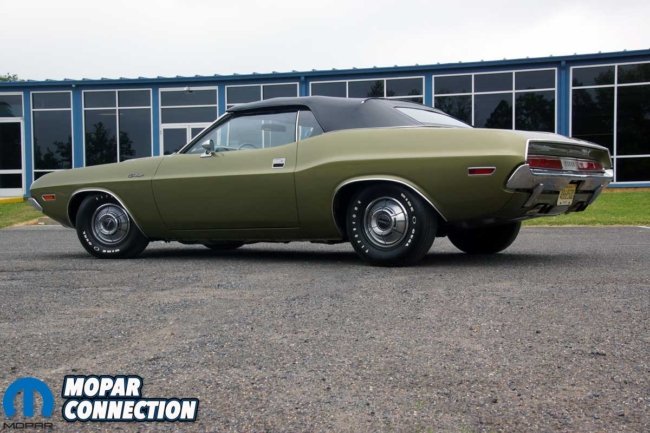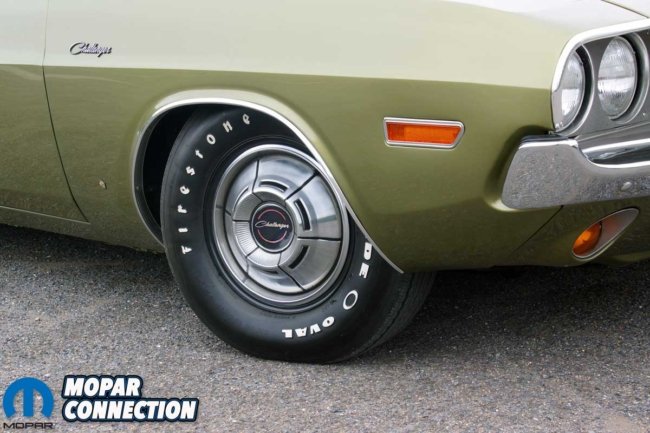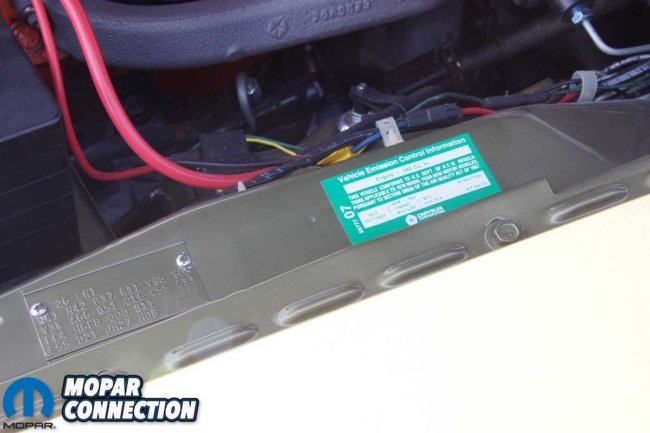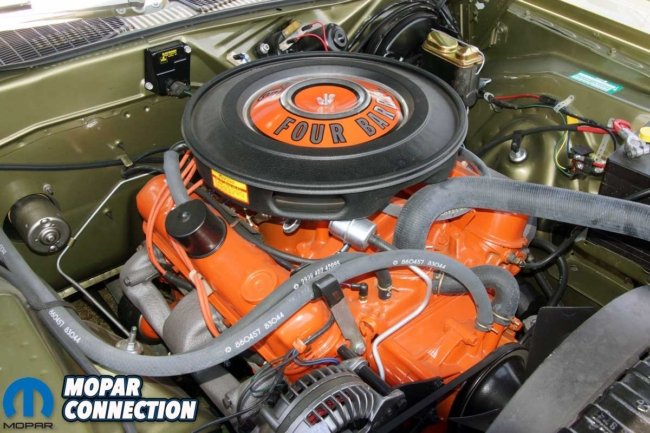
When Dodge unveiled the 1970 Challenger in September of 1969, the performance-oriented Challenger R/T was only to receive Dodge’s big-block engine options with carburation of a 4-barrel or more, which included the standard 383 engine or the options of a 440 or 426 Hemi.
However, when Plymouth added the 340 as an engine option to accompany the big-block engine options for the ‘Cuda, Dodge was caught flatfooted. The quick fix was to offer a 340 coupled with all the R/T components but without the R/T badging. As a result, these single-year 340 Challengers have become desirable and are referred to as A66 Challengers; A66 is the build code number.
The A66, listed as the Challenger 340 Performance Package in the Dodge literature, included the 340 (code E55), R/T-style performance hood, heavy-duty brakes and suspension, a Sports Stripe, aka the Bumble Bee Stripe (may be deleted), a “Scat Pack” decal on rear quarter panel, and the standard wheel lip molding deleted.
Original dealer information showed only a 15-inch Rallye Wheel (code W21) and compact spare (code W34) as mandatory options for the A66 package (announced on 7/7/69 starting with September builds). However, later data shows 14-inch wheels as standard without needing a collapsible spare (announced on 10/20/69).
The Shaker Hood became an option with the A66 package (announced on 4/13/70), and the Challenger T/A fiberglass hood (code N94) also became an option on the same date for all 4-barrel engines. However, the T/A hood was not an option with the Shaker Hood, Molding Group A (code A63), or Special Edition (SE) models.
In 1970, Dodge produced 76,935 base, R/T, and Special Edition Challengers. The total production numbers for 340 hardtops are less clear. However, there is a consensus that Dodge built 6933 340 Challengers in 1970. That number includes 2400 (also listed as 2399 by other sources) 340 T/A Challengers. The remaining 4533 340 Challengers were code A66 vehicles.
The A66 Challengers break down with 2360 fitted with a 3-speed Torqueflite automatic transmission, 1830 came with a manual 4-speed, and 343 were equipped with a manual 3-speed. According to the A66 Registry, there were 264 convertibles built with a 340. Of those, 178 were fitted with a Torqueflite, 66 had a 4-speed, and 20 came with a 3-speed.
Rich Gengo of Piscataway, New Jersey, found his A66 ’70 Challenger convertible even though he was not actively searching for one. Rich was at a car show with his restored ’71 ‘Cuda when an attendee approached and asked him, “who did the bodywork and paint?” Rich replied, “I did.” The man continued, “I’ve had a convertible Challenger for a long time, and I am looking to find someone who can do the body and paint.”
The man’s wife was present for the conversation, and she suggested to her husband that he should buy something already done rather than waiting to finish the Challenger. Rich mentioned he had just completed a frame-off restoration of a ’72 Corvette equipped with a 454, 4-speed, T-top, and air conditioning.
Rich avowed, “We can make a deal with the Vette, and you guys can be cruising tomorrow.” Although Rich asked, the Challenger was not for sale. However, the man did not live far from Rich, so they agreed that he could look over the promising Challenger. Upon seeing the convertible, Rich was impressed with the nearly complete car. A deal was struck, and Rich traded the recently restored Corvette for the convertible Challenger and cash.
On May 30, 2015, Rich completed the transaction, and he towed the completely disassembled Challenger to his garage in Piscataway. Over the next two and half years, Rich rebuilt the Challenger. The 340, 4-speed transmission, and the 3.23:1 geared 8 ¾-inch were all refreshed to factory stock specifications. The master cylinder, power booster, front disc and rear drum brakes, and brake lines were reconditioned or replaced with new-old-stock (NOS) components. The heavy-duty suspension received the same detailed restoration.
To return the interior to its original factory appearance, Legendary Interiors provided the carpet, seat covers for the front buckets and the rear seat, and additional soft parts. The interior was finished in F8 green with a woodgrain console, which included the one-year-only seat belt holder at the rear of the console.
The only rust concerns on the Challenger were limited to the bottom corner of one door and the lower section of a front fender. Rich cut out the rust and repaired the damaged areas with metal. To complete the exterior, Rich shot it in the factory FF4 Light Green Metallic color. Next, he installed the chrome racing mirrors (driver’s side remote adjustable) and fitted the bright exhaust tips into the lower rear valance. The Challenger was ordered with a V98 Bumble Bee Stripe delete, and Rich elected to leave off the stripe during the restoration.

The only component that Rich did not complete on the Challenger was the convertible top. He farmed that out to a local upholstery shop. Interestingly, the Challenger was ordered with a V8W white convertible top. When he purchased the car, a black Legendary Interiors’ top was in one of the many boxes included with the purchase of the Challenger. According to Rich, the black top could easily be swapped for a white top if someone wanted it to be original.
To finish the exterior of the Challenger, Rich installed Firestone F70-14 bias-ply look radials rather than the as-delivered Goodyear Polyglas GT tires. The reason was simple. Rich did not like how the Goodyear bias-ply look radial tires had the “R” (for radial) inserted in the raised white letters of the FR70-14 tire size designation rather than the original F70-14. So instead, he ordered Firestone tires, which have the “R” discreetly hidden on the sidewall without raised white letters or highlighting.
For their Challengers, most buyers optioned to purchase 14-inch Road Style or 14- or 15-inch Rallye Wheels. However, there were four-wheel cover options for those ordering steel wheels. The dog dish hub (poverty) caps were standard. Three full-wheel cover designs included wire-wheel-type caps, a deep-dish cover, and the unique W11 caps found on Rich’s Challenger.
Rich states the Challenger rides smoother than his ’71 ‘Cuda, and he attributes the ride quality to the additional weight of the convertible chassis. Not one to sit back and relax, Rich has restored a ‘Cuda for his wife since restoring the Challenger, and he has another project in the works. He is always in the market for something different or rare to refurbish, and with his talent, he will restore the vehicle to a condition better than factory new.





































 Mopar Connection Magazine – The ONLY Daily Mopar Magazine © 2022. All Rights Reserved. Mopar Connection Magazine is the ONLY daily Mopar Magazine bringing you the latest Mopar news, technology, breaking news, and Mopar related events and articles. Find out the latest information about Mopar, Mopar products and services, stay up to date on Mopar enthusiast news, dealership information and the latest Mopar social media buzz! Sign up for the Mopar Connection Magazine newsletter for the latest information about new products, services and industry chatter. Mopar Connection Magazine is the best and only source you need to be a Mopar industry insider!
Mopar Connection Magazine – The ONLY Daily Mopar Magazine © 2022. All Rights Reserved. Mopar Connection Magazine is the ONLY daily Mopar Magazine bringing you the latest Mopar news, technology, breaking news, and Mopar related events and articles. Find out the latest information about Mopar, Mopar products and services, stay up to date on Mopar enthusiast news, dealership information and the latest Mopar social media buzz! Sign up for the Mopar Connection Magazine newsletter for the latest information about new products, services and industry chatter. Mopar Connection Magazine is the best and only source you need to be a Mopar industry insider! by
by